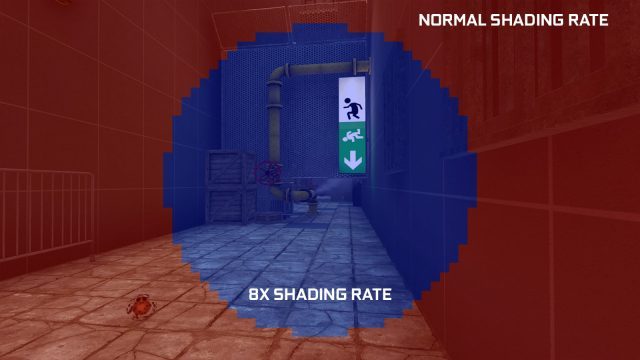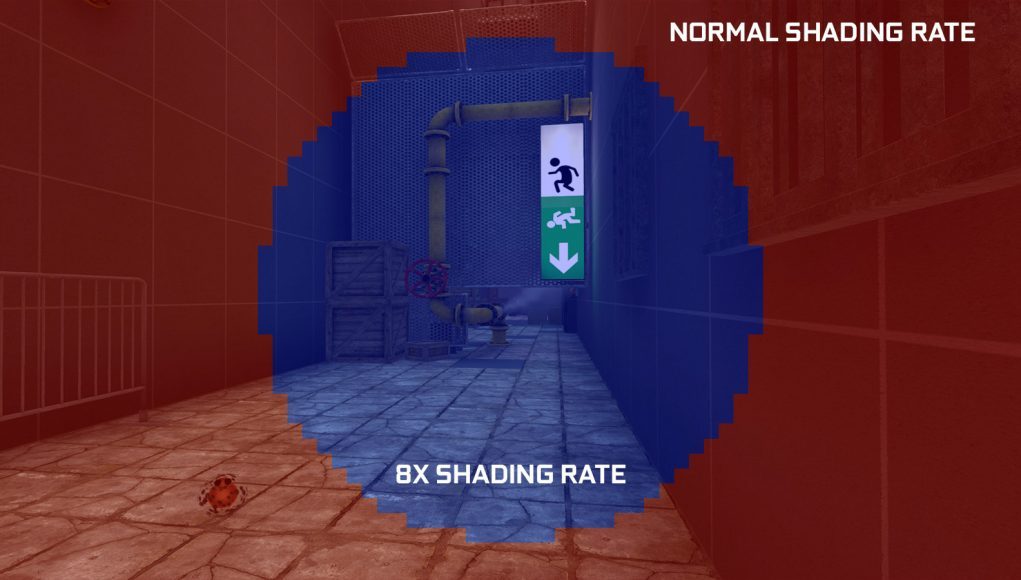NVIDIA is upgrading its Variable Rate Supersampling (VRSS) with support for headsets with eye-tracking, allowing the rendered application to improve performance by increasing quality where the user is looking, while decreasing it elsewhere.
Nvidia today announced the latest version of VRSS, a foveated rendering implementation that works with any of the company’s RTX series GPUs and any application which supports DirectX 11, forward rendering, and MSAA.
The first version of VRSS only offered static foveated rendering which increased the effective resolution at the center of the image (where the lens is the sharpest), while decreasing the quality outside of the central area, effectively concentrating the GPU power where it matters most. The foveated rendering region can be supersampled up to 8x.

VRSS 2 adds support for dynamic foveated rendering which allows the system to move the supersampled area to wherever the eye is looking. Although lens sharpness drops off as the user looks away from the center of the lens, there can still be perceptual benefits to supersampling outside the center of the lens.
This of course only works for headsets equipped with eye-tracking tracking, which is not common in consumer-grade VR headsets today, but is expected to become more widespread in the future.
Out of the gate, Nvidia says that the dynamic foveated rendering in VRSS 2 will support HP’s new Reverb G2 Omnicept Edition headset. In the future we hope to see support added for HTC’s Vive Pro Eye and Varjo headsets, both of which include eye-tracking hardware.
VRSS 2 is supported as of GeForce driver version R465 which became available on March 30th. Users must enable VRSS via the Nvidia Control Panel (Manage 3D Settings > Global Settings > Virtual Reality – Variable Rate Supersampling > Adaptive).
Although eye-tracking headsets themselves appear to require per-headset integrations to support dynamic foveated rendering with VRSS 2, Nvidia says that applications don’t need to be modified in any way to get the benefits of VRSS 2, provided they support DirectX 11, forward rendering, and MSAA. That’s a good thing because it means developers don’t need to rely on any technology that’s specific to Nvidia GPUs in order to benefit from VRSS 2.
Developers with compatible titles need only to submit their application to Nvidia for consideration. If the application benefits from VRSS 2, Nvidia will whitelist the app to use VRSS 2 in a future driver update.
Nvidia today also published a new list with all games currently supporting VRSS:
| Games Supporting NVIDIA VRSS – April 12th, 2021 | |
| Battlewake | Raw Data |
| Boneworks | Rec Room |
| Budget Cuts 2: Mission Insolvency | Rick & Morty: Virtual Rick-ality |
| Doctor Who: The Edge of Time | Robo Recall |
| Eternity Warriors VR | Sairento VR |
| Hot Dogs, Horeshoes, & Hand Grenades | Serious Sam VR: The Last Hope |
| In Death | Skeet: VR Target Shooting |
| Job Simulator | Sniper Elite VR |
| Killing Floor: Incursion | Space Pirate Trainer |
| L.A. Noire VR | Special Force VR: Infinity War |
| Lone Echo | Spiderman Far From Home |
| Medal of Honor: Above and Beyond | Spiderman Homecoming VR |
| Mercenary 2: Silicon Rising | Talos Principle VR |
| Onward VR | The Soulkeeper VR |
| Pavlov VR | The Walking Dead: Saints & Sinners |
| PokerStars VR | VRChat |







